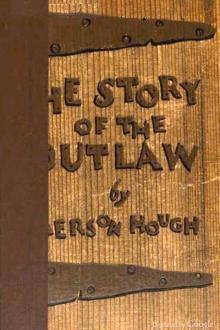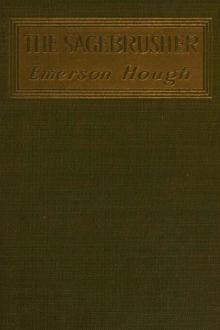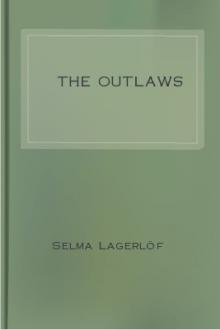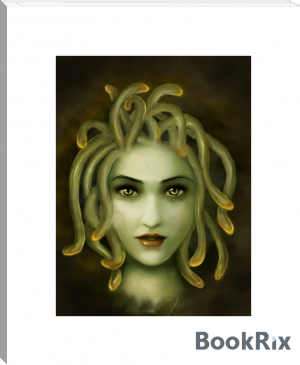The Story of the Outlaw, Emerson Hough [ereader that reads to you txt] 📗

- Author: Emerson Hough
- Performer: -
Book online «The Story of the Outlaw, Emerson Hough [ereader that reads to you txt] 📗». Author Emerson Hough
The true name of Billy the Kid was William H. Bonney, and he was born in New York City, November 23, 1859. His father removed to Coffeyville, on the border of the Indian Nations, in 1862, where soon after he died, leaving a widow and two sons. Mrs. Bonney again moved, this time to Colorado, where she married again, her second husband being named Antrim. All the time clinging to what was the wild border, these two now moved down to Santa Fé, New Mexico, where they remained until Billy was eight years of age. In 1868, the family made their home at Silver City, New Mexico, where they lived until 1871, when Billy was twelve years of age. His life until then had been one of shifting about, in poverty or at best rude comfort. His mother seems to have been a wholesome Irishwoman, of no great education, but of good instincts. Of the boy's father nothing is known; and of his stepfather little more, except that he was abusive to the stepchildren. Antrim survived his wife, who died about 1870. The Kid always said that his stepfather was the cause of his "getting off wrong."
The Kid was only twelve years old when, in a saloon row in which a friend of his was being beaten, he killed with a pocket-knife a man who had previously insulted him. Some say that this was an insult offered to his mother; others deny it and say that the man had attempted to horsewhip Billy. The boy turned up with a companion at Fort Bowie, Pima county, Arizona, and was around the reservation for a while. At last he and his associate, who appears to have been as well saturated with border doctrine as himself at tender years, stole some horses from a band of Apaches, and incidentally killed three of the latter in a night attack. They made their first step at easy living in this enterprise, and, young as they were, got means in this way to travel about over Arizona. They presently turned up at Tucson, where Billy began to employ his precocious skill at cards; and where, presently, in the inevitable gambler's quarrel, he killed another man. He fled across the line now into old Mexico, where, in the state of Sonora, he set up as a youthful gambler. Here he killed a gambler, José Martinez, over a monte game, on an "even break," being the fraction of a second the quicker on the draw. He was already beginning to show his natural fitness as a handler of weapons. He kept up his record by appearing next at Chihuahua and robbing a few monte dealers there, killing one whom he waylaid with a new companion by the name of Segura.
Said to have slain twenty-two men in his short career.
Killed when twenty-one years old by Sheriff Pat F. Garrett
The Kid was now old enough to be dangerous, and his life had been one of irresponsibility and lawlessness. He was nearly at his physical growth at this time, possibly five feet seven and a half inches in height, and weighing a hundred and thirty-five pounds. He was always slight and lean, a hard rider all his life, and never old enough to begin to take on flesh. His hair was light or light brown, and his eyes blue or blue-gray, with curious red hazel spots in them. His face was rather long, his chin narrow but long, and his front teeth were a trifle prominent. He was always a pleasant mannered youth, hopeful and buoyant, never glum or grim, and he nearly always smiled when talking.
The Southwestern border at this time offered but few opportunities for making an honest living. There were the mines and there were the cow ranches. It was natural that the half-wild life of the cow punchers would sooner or later appeal to the Kid. He and Jesse Evans met somewhere along the lower border a party of punchers, among whom were Billy Morton and Frank Baker, as well as James McDaniels; the last named being the man who gave Billy his name of "The Kid," which hung to him all his life.
The Kid arrived in the Seven Rivers country on foot. In his course east over the mountains from Mesilla to the Pecos valley he had been mixed up with a companion, Tom O'Keefe, in a fight with some more Apaches, of whom the Kid is reported to have killed one or more. There is no doubt that the Guadalupe mountains, which he crossed, were at that time a dangerous Indian country. That the Kid worked for a time for John Chisum, on his ranch near Roswell, is well known, as is the fact that he cherished a grudge against Chisum for years, and was more than once upon the point of killing him for a real or fancied grievance. He left Chisum and took service with J. H. Tunstall on his Feliz ranch late in the winter of 1877, animated by what reason we may not know. In doing this, he may have acted from pique or spite or hatred. There was some quarrel between him and his late associates. Tunstall was killed by the Murphy faction on February 18, 1878. From that time, the path of the Kid is very plain and his acts well known and authenticated. He had by this time killed several men, certainly at least two white men; and how many Mexicans and Indians he had killed by fair means or foul will never be really known. His reputation as a gun fighter was well established.
Dick Brewer, Tunstall's foreman, was now sworn in as a "special deputy" by McSween, and a war of reprisal was now on. The Kid was soon in the saddle with Brewer and after his former friends, all Murphy allies. There were about a dozen in this posse. On March 6, 1878, these men discovered and captured a band of five men, including Frank Baker and Billy Morton, both old friends of the Kid, at the lower crossing of the Rio Peñasco, some six miles from the Pecos. The prisoners were kept over night at Chisum's ranch, and then the posse started with them for Lincoln, not taking the Hondo-Bonito trail, but one via the Agua Negra, on the east side of the Capitans; proof enough that something bloody was in contemplation, for that was far from any settlements. Apologists of the Kid say that Morton and Baker "tried to escape," and that the Kid followed and killed them. The truth in all probability is that the party, sullen and bloody-minded, rode on, waiting until wrath or whiskey should inflame them so as to give resolution for the act they all along intended. The Kid, youngest but most determined of the band, no doubt did the killing of Billy Morton and Frank Baker; and in all likelihood there is truth in the assertion that they were on their knees and begging for their lives when he shot them. McClosky was killed by McNab, on the principle that dead men tell no tales. This killing was on March 9, 1878. The murder of Sheriff William Brady and George Hindman by the Kid and his half-dozen companions occurred April 1, 1878, and it is another act which can have no palliation whatever.
The Kid was now assuming prominence as a gun fighter and leader, young as he was. After the big fight in Lincoln was over, and the McSween house in flames, the Kid was leader of the sortie which took him and a few of his companions to safety. The list of killings back of him was now steadily lengthening, and, indeed, one murder followed another so fast all over that country that it was hard to keep track of them all.
The killing of the Indian agency clerk, Bernstein, August 5, 1878, on a horse-stealing expedition, was the next act of the Kid and his men, who thereafter fled northeast, out through the Capitan Gap, to certain old haunts around Fort Sumner, some ninety miles north of Roswell, up the Pecos valley. Here a little band of outlaws, led by the Kid, lived for a time as they could by stealing horses along the Bonito and around the Capitans, and running them off north and east. There were in this band at the time the Kid, Charlie Bowdre, Doc Skurlock, Wayt, Tom O'Folliard, Hendry Brown and Jack Middleton. Some or all of these were in the march with stolen horses which the Kid engineered that fall, going as far east as Atacosa, on the Canadian, before the stock was all gotten rid of. Middleton, Wayt, and Hendry Brown there left the Kid's gang, telling him that he would get killed before long; but the latter laughed at them and returned to his old grounds, alternating between Lincoln and Fort Sumner, and now and then stealing some cows from the Chisum herd.
In January, 1880, the Kid enlarged his list of victims by killing, in a very justifiable encounter, a bad man from the Panhandle by the name of Grant, who had been loafing around in his country, and who, no doubt, intended to kill the Kid for the glory of it. The Kid had, a few moments before he shot Grant, taken the precaution to set the hammer of the latter's revolver on an "empty," as he whirled it over in examination. They were apparently friends, but the Kid knew that Grant was drunk and bloodthirsty. He shot Grant twice through the throat, as Grant snapped his pistol in his face. Nothing was done with the Kid for this, of course.
Birds of a feather now began to appear in the neighborhood of Fort Sumner, and the Kid's gang was increased by the addition of Tom Pickett, and later by Billy Wilson, Dave Rudabaugh, Buck Edwards, and one or two others. These men stole cattle now from ranges as far east as the Canadian, and sold them to obliging butcher-shops at the new mining camp of White Oaks, just coming into prominence; or, again, they took cattle from the lower Pecos herds and sold them north at Las Vegas; or perhaps they stole horses at the Indian reservation and distributed them along the Pecos valley. Their operations covered a country more than two hundred miles across in either direction. They had accomplices and friends in nearly every little placita of the country. Sometimes they gave a man a horse as a present. If he took it, it meant that they could depend upon him to keep silent. Partly by friendliness and partly by terrorizing, their influence was extended until they became a power in all that portion of the country; and their self-confidence had now arisen to the point that they thought none dared to molest them, while in general they behaved in the high-handed fashion of true border bandits. This was the heyday of the Kid's career.
It was on November 27, 1880, that the Kid next added to his list of killings. The men of White Oaks, headed by deputy sheriff William Hudgens, saloon-keeper of White Oaks, formed a posse, after the fashion of the day, and started out after the Kid, who had passed all bounds in impudence of late. In this posse were Hudgens





Comments (0)